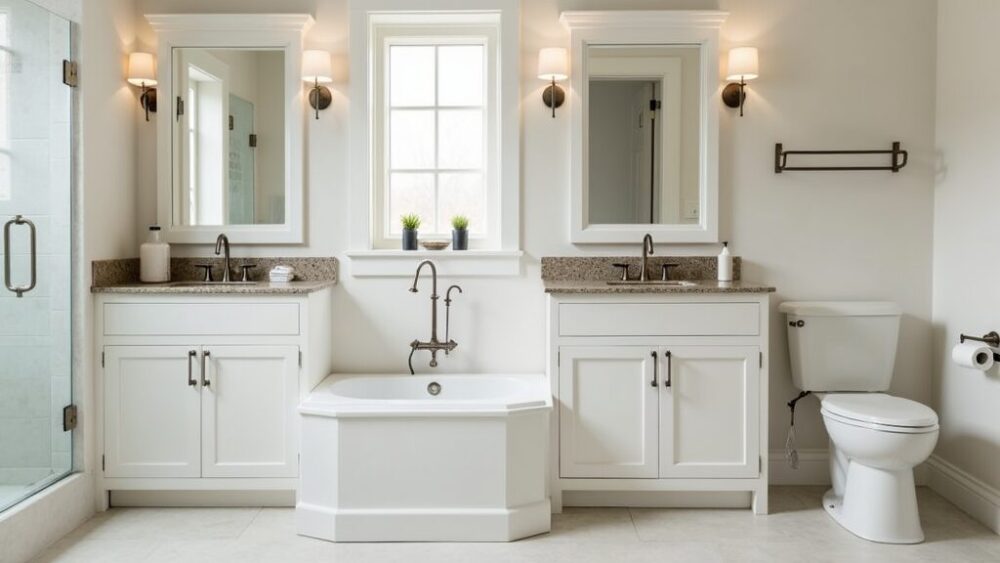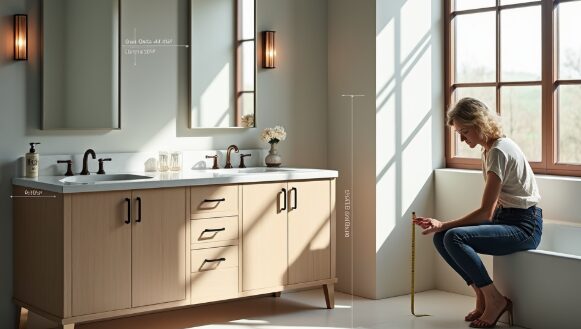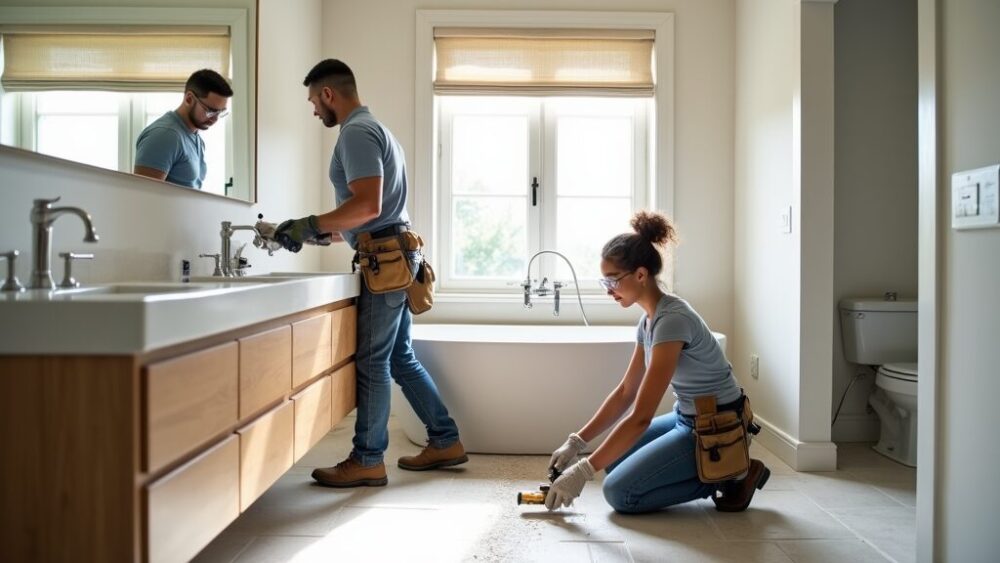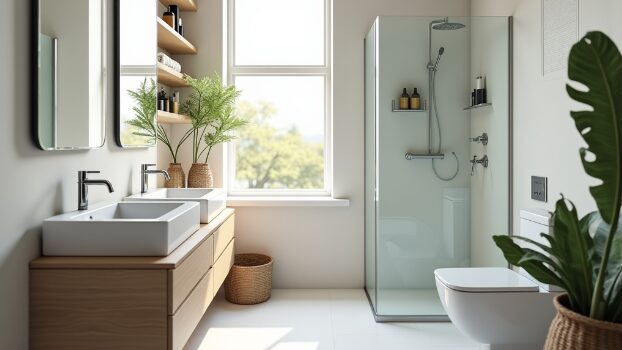When undertaking a bathroom remodel or simply updating fixtures, understanding the average lifespan of bathroom fixtures and materials is crucial. This knowledge aids homeowners in making informed decisions regarding investments and maintenance.
The durability of bathroom components varies, influenced by quality, usage, and maintenance practices. This article delves into common bathroom fixtures and materials, providing insights into their longevity and the role of professional remodeling contractor services in ensuring the longevity and functionality of these components.
Table of Contents

1. Introduction to Bathroom Durability
Bathrooms are high-traffic areas subject to moisture, daily use, and wear and tear. The choice of materials and fixtures significantly impacts their lifespan, functionality, and aesthetic appeal. High-quality installations by experienced residential remodeling contractors can extend the lifespan of bathroom components, ensuring they remain functional and visually appealing for as long as possible. Experienced residential remodeling contractors can offer valuable insights and recommendations for selecting durable materials and fixtures that can withstand the challenges of a bathroom environment. Their expertise can also help homeowners achieve stunning bathroom remodeling results that not only meet their aesthetic preferences but also remain functional and reliable for years to come. With the right guidance and expertise, homeowners can make informed decisions that will enhance the longevity and appeal of their bathroom spaces.
2. Importance of Professional Installation
The expertise of local remodeling contractors is invaluable in bathroom renovations. Professional remodeling contractor services ensure that installations are done correctly, adhering to building codes and manufacturer recommendations. This not only optimizes the functionality of each component but also maximizes its lifespan, offering homeowners peace of mind and potential savings on future repairs or replacements.

3. Lifespan of Bathroom Fixtures
Toilets: A well-maintained toilet can last 50 years or more. However, internal components like flappers and fill valves may need replacement every 5 to 10 years.
- Faucets and Showerheads: Quality faucets and showerheads can last 15 to 20 years. Regular cleaning to remove mineral deposits can extend their lifespan. However, due to advancements in technology and water conservation, homeowners often update these fixtures to more efficient models before the end of their useful life.
- Bathtubs: The durability of bathtubs varies by material. Acrylic and fiberglass tubs typically last 10 to 15 years, while cast iron and stone resin tubs can last 30 years or more. Proper care and maintenance are crucial for maximizing the lifespan of bathtubs.
- Shower Enclosures: Glass shower enclosures can last up to 30 years with proper maintenance. The lifespan of shower doors is influenced by the quality of the hardware and the frequency of use.
- Tiles: Ceramic and porcelain tiles can last more than 50 years when properly installed and maintained. The longevity of tile grout is approximately 10 years, although it can last longer with proper sealing and care.
- Countertops: The lifespan of bathroom countertops depends on the material. Laminate countertops may last 10 to 20 years, while granite and quartz can last 30 years or more with proper care.
- Cabinetry: Bathroom cabinetry can last 30 to 50 years. The lifespan is influenced by the quality of materials, construction, and exposure to moisture. Regular maintenance and use of exhaust fans can help prevent moisture damage.
4. Role of Remodeling Contractors in Maintenance and Replacement
Residential remodeling contractors play a vital role in the maintenance, replacement, and upgrade of bathroom fixtures and materials. Their expertise can guide homeowners in choosing durable materials suited to their lifestyle and bathroom usage patterns. Local remodeling contractors can also provide valuable services such as regular maintenance checks and updates to fixtures, extending their lifespan and ensuring the bathroom remains a functional and inviting space.

5. Factors Influencing Lifespan
Several factors influence the lifespan of bathroom fixtures and materials:
- Quality of Materials: Higher quality materials generally have a longer lifespan.
- Installation: Professional installation by experienced remodeling contractors can significantly impact durability.
- Maintenance: Regular cleaning and maintenance extend the life of bathroom components.
- Usage: The frequency and manner of use can affect how long fixtures and materials last.
6. Updating Bathroom Fixtures and Materials
While some bathroom components have long lifespans, updating them before they reach the end of their useful life can have several benefits. New fixtures and materials can improve water efficiency, enhance the bathroom’s aesthetic appeal, and increase home value. Consulting with remodeling contractor services can provide insights into the most beneficial updates, ensuring homeowners make informed decisions about renovations.
Conclusion: Understanding the Average Lifespan of Bathroom Fixtures And Materials
The average lifespan of bathroom fixtures and materials varies widely, influenced by factors such as material quality, installation practices, and maintenance. Engaging professional residential remodeling contractors for installation and maintenance can maximize the longevity and functionality of these components.
Regular updates and replacements, guided by the expertise of local remodeling contractors, can also enhance the efficiency, aesthetics, and value of the bathroom. Ultimately, understanding the expected lifespans of bathroom components allows homeowners to plan for timely updates and maintenance, ensuring their bathroom remains a comfortable, functional, and stylish space for years to come.
- Remodeling Vancouver WA
- Bathroom Remodeling Vancouver WA
- Kitchen Remodeling Vancouver WA
- Siding Contractor Vancouver WA
- Flooring Contractor Vancouver WA
- Window Replacement Vancouver WA
- New Additions Vancouver WA
- Deck Builders Vancouver WA
- Interior Finish Work Vancouver WA
- General Contractor Battle Ground WA

